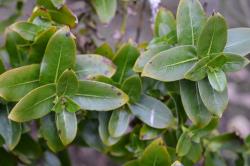- Taxon
- Gallery
Evergreen, glabrous, dioecious shrubs, 1—2—(3) m tall. Primary stems one to several, erect, to 4 cm basal diam., with few branches; secondary stems erect, produced by epicormic growth from collapsed primary stems. Outer bark at base of stem yellowish brown; inner bark, when bared, pale green. Stem internodes 1-2 cm apart in scrub canopy, to 10-15 cm in forest understorey. Leaves subsessile, on petioles 0.5-1 mm long. Lamina oblong to narrowly ovate-oblong, to 5 × 3 cm in open, to 18 × 7 cm in shade, rigid in open (0.45-0.55 mm thick), flaccid in shade (0.25-0.35 mm thick); apex mucronate, deflexed 45°-90° and shallowly channelled to form conspicuous "drip-tip" to 1.5 cm long X1.5 cm wide; domatia present in axils of main veins except in shade leaves; base cordate, with lobes to 4 mm in open, to 9 mm in shade; each lobe ± appressed against lobe of opposing lamina. Upper surface of lamina dark green, slightly to very glossy; mid-vein pale, contrasting strongly with rest of lamina; veins prominent, raised; lateral vein angle (at mid-point of lamina) 70°-85°. Lower surface of lamina pale green, slightly glossy; mid-vein pale, contrasting weakly with rest of leaf; veins prominent but only the mid-vein raised. Lamina margins very shallowly crenate near apex, and usually bearing widely-spaced, minute, antrorse teeth, 0.1-0.2 mm long, especially in shaded plants. Stipules in adult plants up to 7 mm long; stipular* sheath thin, to c. 1 mm long (from top of petiole at junction with stem to upper margin of sheath); apex, adaxial surface, and marginal parts of the abaxial surface of the stipule glandular; denticles numerous, on the apex, on the margins, and on the adaxial surface of the stipule, most appearing as ± rounded protuberances, irregular in distribution and shape, on the glandular surface, but a few minute ones present on the non-glandular sheath margin above the petiole junction, and occasionally one or two present on the abaxial, non-glandular surface of the stipule. ♀ Inflorescences lateral, in 3-4 opposite pairs towards tip of main leafy stem and arching away from it, multi-branched, every branch potentially bearing a flower; primary inflorescence branch 1-3 cm long (elongating after flowering to 3-5 cm) with 1-2-(3) nodes at decreasing intervals; secondary branches 0.1-0.5-( 1.5) cm long; subsequent branches very short to virtually absent with the only evidence for them being the presence of two minute bracts and twominute stipules at the base of each flower; bracts at first node on primary branch 2-6 mm long; all other bracts smaller; flowers (3)-10-25-(30) per inflorescence, aggregated into 1-4 clusters, with 3—9—(13) flowers in each cluster. ♀ Flowers: calyx minute with irregularly-lobed rim; lobes 0.05-0.35 mm long; corolla fleshy, firm, c. 2 mm diam.,4-lobed, pale greenish-yellow with a few streaks of purple; corolla tube funnel-form, c. 2 mm long; corolla lobes curved outwards, c. 1.6 mm long × c. 1 mm wide at base, tips subacute, minutely papillose; stigmas 2 (rarely 3), 5-10 mm long, bent outwards to c. 90°. ♂ Inflorescences lateral, in 6-7 opposite pairs towards tip of main leafy stem and arching away from it, multi-branched, every branch potentially bearing a flower; primary inflorescence branch (1.5)-2.0-3.0 cm long with 1-(2) nodes; branch increasing in diam. from c. 1.5 mm at base to c. 2 mm just below terminal cluster of flowers; secondary branches and subsequent branches very short to virtually absent with the only evidence for them being the presence of two minute bracts and two minute stipules at the base of each flower; bracts at first node 3-5-(7) mm long; all other bracts smaller; flowers 10—15—(17) per inflorescence, usually aggregated into a single cluster, occasionally into two, with 6-15 flowers in each cluster. ♂ Flowers: calyx minute with irregularly-lobed rim; lobes 0.2-0.7 mm long; corolla fleshy, firm, 5-8 mm diam., 4-(5)-lobed, pale greenish-yellow with tips of lobes ± streaked with purple; corolla tube funnel-form, 5-6 mm long; corolla lobes curved outwards, 2.0-2.5 mm wide at base × 3-4 mm long, tips rounded to subacute, minutely papillose; stamens 4, 1.0-1.8 cm long; anthers 3-4 mm long. Drupes distinctly didymous when green; depressed-globose and slightly asymetrical about axis when ripe, glossy, (5)-6-7-(8) mm deep × (6)-7-8-(9) mm × (7)-8-9-(10) mm; exocarp becoming at first yellow, then orange, finally orangered; mesocarp similarly pigmented. Pyrenes 1-2 (rarely 3), ovate in dorsal view, 4-5 mm long × 2-3 mm wide × > 3 mm maximum depth from ventral to dorsal surface, with pronounced median rib on rounded dorsal surface, more strongly developed in lower two-thirds; apex subacute to acute; dorsal and ventral surfaces rugose and minutely striate; operculum hardly differentiated from rest of surface, narrow, width < 1/3 length, sides ± parallel; ventral surface flat when two pyrenes develop equally, bulging in lower half and slightly concave in operculum area when only one pyrene develops fully (the most common situation); pyrenes + trigonous when three develop, even partially.
[Reproduced from Druce (1989, New Zealand J. Bot. 27: 119–128) with permission from The Royal Society of New Zealand.]




